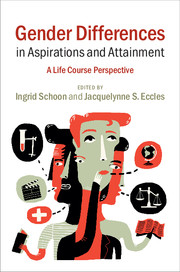Book contents
- Frontmatter
- Contents
- List of Figures
- List of Tables
- Notes on Contributors
- List of Abbreviations (selected)
- Part I Introduction
- Introduction Conceptualizing gender differences in aspirations and attainment
- Part II The early school years
- Part III Career planning during adolescence
- Part IV Choosing a science career
- Part V Longer-term consequences of early experiences
- Part VI The role of context
- Index
- References
Introduction - Conceptualizing gender differences in aspirations and attainment
A life course perspective
Published online by Cambridge University Press: 05 October 2014
- Frontmatter
- Contents
- List of Figures
- List of Tables
- Notes on Contributors
- List of Abbreviations (selected)
- Part I Introduction
- Introduction Conceptualizing gender differences in aspirations and attainment
- Part II The early school years
- Part III Career planning during adolescence
- Part IV Choosing a science career
- Part V Longer-term consequences of early experiences
- Part VI The role of context
- Index
- References
Summary
This book introduces a life course perspective to the study of gender differences in aspirations and attainment, addressing the interplay of individual and structural factors in shaping the lives of men and women and how this interplay develops over time and in context. It examines and describes how aspirations, self-concepts, and attainments form and develop during childhood, adolescence, young adulthood, and later in adult life, and brings together evidence from across disciplines to gain a better understanding of the multiple influences on individual lives.
Gender differences in educational attainment and future outlook have been a topic of public debate since the late 1980s. Initially the focus was on the underrepresentation of females in the sciences. More recently focus has shifted to a concern about the academic underachievement of males – following evidence suggesting that boys were failing to improve their educational performance at the same rate as girls, and that girls were overtaking boys in their academic motivation and the level of qualifications obtained (Arnot, 2002; DiPrete & Buchmann, 2013). Beginning in elementary school, girls outperform boys and this gap continues throughout secondary school and higher education. The academic success and achievements of girls have been hailed as a story of the extraordinary success of post-war egalitarian movements. However, the shift in the gender balance, with girls catching up with or overtaking boys in their academic motivation and academic attainments, has also brought about something of a moral panic, leading to calls for support for underachieving boys to retrieve their educational advantage (Epstein, Elwood, Hey, & Maw, 1998; Younger & Warrington, 2006). The threat of boys’ disengagement from the educational system is of particular concern in the current era of growing knowledge economies requiring a highly skilled labor force. However, it has also been argued that recent gains of women in the educational system reflect a “stalled gender revolution” (Carlson, 2011; England, 2010), affecting some groups and some areas of life more than others.
- Type
- Chapter
- Information
- Gender Differences in Aspirations and AttainmentA Life Course Perspective, pp. 3 - 26Publisher: Cambridge University PressPrint publication year: 2014
References
- 9
- Cited by

